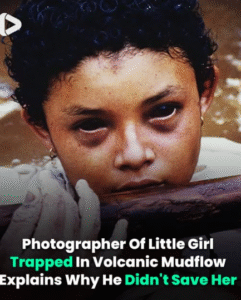The haunting image of a young girl named Omayra Sánchez, trapped in volcanic mudflow after the 1985 eruption of the Nevado del Ruiz volcano in Colombia, remains one of the most powerful and tragic photographs in history. The photo, taken by Colombian photojournalist Frank Fournier, sparked global outrage and heartbreak. But many have asked: Why didn’t the photographer save her?
Fournier has spoken publicly about that moment and his decision. According to him, by the time he arrived at the disaster site, Omayra had already been trapped for nearly two days. Her legs were pinned under debris in deep water and volcanic mud, entangled in the ruins of her collapsed home. Rescue workers had tried to free her, but they didn’t have the equipment needed to do it without fatally injuring her.
Fournier said that when he met Omayra, she was calm, brave, and spoke openly, even singing and asking for food and soda. He recalls being deeply moved and helpless, knowing that her survival chances were slipping away by the hour. Rescue crews were doing all they could, but the situation required heavy machinery that simply wasn’t available in time.
Fournier’s role, he explained, was to document what was happening so the world would understand the scope of the tragedy—and the failure of the Colombian government to act quickly. His photograph of Omayra’s face—mud-covered, eyes haunted, yet full of dignity—was published worldwide and won the World Press Photo of the Year in 1986. But it also came with heavy criticism and moral questioning.
In response, Fournier said he did not take the picture lightly. He stated that photographing her was not about exploitation, but about telling the truth. “It was the only thing I could do,” he said. “She needed the world to see her, and others like her, who had been abandoned.”
The image became a symbol not only of human suffering, but also of the consequences of government neglect and poor disaster preparedness. Omayra died shortly after the photo was taken. Her death sparked international pressure on the Colombian government and brought attention to the importance of timely disaster response.
Fournier has said he still carries the emotional weight of that day. He didn’t see himself as a hero or a villain—just a witness to a tragedy he could not stop. His photograph did not save Omayra, but it gave her a voice, even in death.


